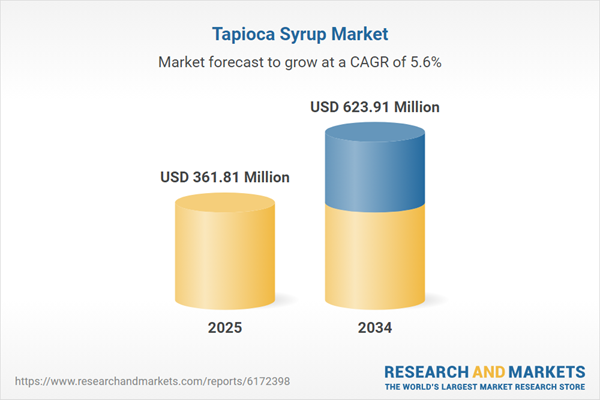The Thriving Food and Beverages Industry is Aiding the Global Market for Tapioca Syrup
The nutritional and other benefits provided by tapioca syrup over sucrose is resulting in its enhanced demand in the food and beverage industry. It can be used as an alternative to highly-processed options, such as sugar and corn syrup, as well as more natural substitutes, like honey and maple syrup. Moreover, tapioca syrup has even gained approval for gluten-free and grain-free diets, and, if organic, it is free from pesticides or genetically modified elements. Thus, the highly versatile nature of tapioca syrup allows the manufacturers to use it as a natural or healthier sweetener, and as binding or texturising agents for everything from beverages to confectionery, and processed meats to pie fillings and sauces. The growing consumption of bakery products, such as waffles, pancakes, French toast, and others, along with the increasing demand for healthier beverages like energy drinks, is aiding the growth of the industry.Region-wise, the industry is expected to witness an increased product demand from the Asia-Pacific owing to the thriving food and beverage sector. Meanwhile, North America and Europe are also expected to provide significant growth opportunities for the market expansion due to the growing demand for natural sweeteners in the regions.
Tapioca Syrup: Market Segmentation
Tapioca syrup is a kind of natural liquid sweetener produced from tapioca starch, a product obtained from cassava roots. This clear, neutral-flavoured syrup is widely utilised in the food and beverage industry to add sweetness to various products. Tapioca syrup is used as an alternative to sucrose as it has higher nutritional value than sugar crystals, while its composition is similar to that of sucrose. It possesses high solubility and serves as an instant source of energy through the balanced distribution of simple and complex carbohydrate components.Based on source, the market is bifurcated into:
- Organic
- Conventional
On the basis of DE level, the industry has been categorised into the following:
- < 40
- 40 to 60
- >60
- High Maltose
Based on application, the industry can be segmented into:
- Bakery
- Beverage
- Bars and Cereals
- Confectionery and Snacks
- Dressings and Sauces
- Dairy
- Pharmaceuticals
- Others
The major distribution channels available for the product include:
- Supermarkets/Hypermarkets
- Convenience Stores
- Online
- Others
The regional markets for the product include:
- North America
- Europe
- Asia-Pacific
- Latin America
- Middle East and Africa
Growing Health Consciousness to Bolster the Market Growth for Tapioca Syrup
The rising health awareness among consumers is driving the demand for natural and healthier sweeteners from the major end-use industries. As tapioca syrup contains fewer calories and carbs as compared to sugar, is plant-based, and offers additional benefits over sucrose, its demand is significantly increasing in food products, beverages, dairy, and pharmaceuticals. The growing demand for baked products, confectionery, ready-to-drink beverages, and others is significantly contributing to the industry growth. The market is being supported by the rising disposable incomes, growing retail sector, improving standards of living, and technological advancements.Over the forecast period, the growing demand for organic and vegan food products is expected to drive the demand for tapioca syrup for various applications. This is expected to have a positive effect on the expansion of the market in the next five years.
Key Industry Players in the Global Tapioca Syrup Market
- Cargill Inc.
- Grain Processing Corporation
- Malt Products Corporation
- Briess Products Ltd
- Marigold Inc
- Sunrise International Inc.
- Others
Table of Contents
Companies Mentioned
The key companies featured in this Tapioca Syrup market report include:- Cargill Inc.
- Grain Processing Corporation
- Malt Products Corporation
- Briess Products Ltd
- Marigold Inc
- Sunrise International Inc.
Table Information
| Report Attribute | Details |
|---|---|
| No. of Pages | 157 |
| Published | August 2025 |
| Forecast Period | 2025 - 2034 |
| Estimated Market Value ( USD | $ 361.81 Million |
| Forecasted Market Value ( USD | $ 623.91 Million |
| Compound Annual Growth Rate | 5.6% |
| Regions Covered | Global |
| No. of Companies Mentioned | 7 |









